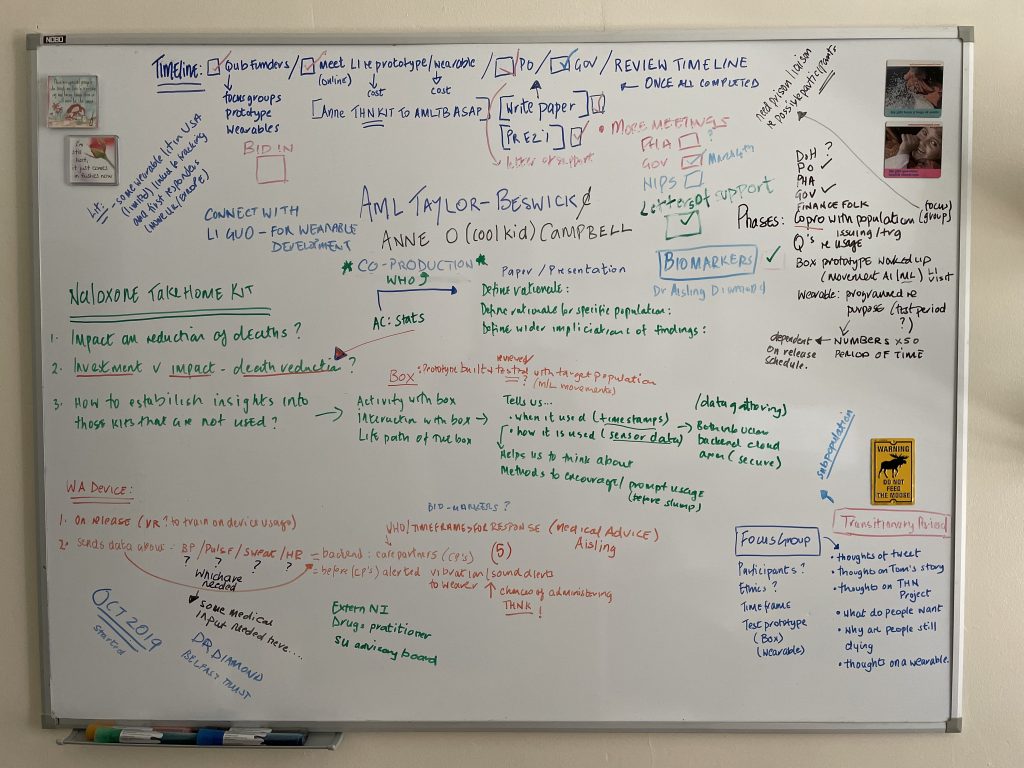Queens University Belfast, Extern NI, Manchester Metropolitan University
The development and use of wearable devices as a response to Opioid Overdose in High Risk Populations
Dr Anne Campbell, Dr Sharon Millen, Dr Amanda ML Taylor-Beswick, Drugs and Alcohol Research Network (DARN), Queen’s University Belfast, Dr Li Guo (Manchester Metropolitan University) and People with lived experience.
This co-produced research project was designed to co-develop, co-refine and test the feasibility of ‘wearable’ devices as a response to reducing opioid overdose. Initially, in the released from prison opioid using population, and in the context of increasing drug related deaths and the issuing of the anecdote Nalaxone on release.
Dr Taylor-Beswick is world renowned for her work at digital and social issues intersections. Dr Campbell is also internationally renowned for her involvement in shaping and informing policy and practice in the field of drugs and alcohol. This project is a result of the merging of the research interests of these colleagues, and the expertise of Dr Li Guo, (Manchester Metropolitan University). Dr Guo is an established computer scientist, who has a robust track record in the development of wearable technology as a response to health and social care issues.
In this study, we are assessing the feasibility of ‘wearing’ a device within a sample from a homeless hostel population. The device will monitor the wearer’s vital signs, with the aim of alerting the wearer to a potential overdose; triggering help that would in the first instance take the form of the self-administration of the drug Naloxone, or if no response, supported by GPS technology, dial out to emergency medical services for help and treatment. Dr Sharon Millen is a Research Fellow in QUB and has twenty years of research experience in the sector. The co-productive aspect of the work and the fieldwork in a prison and hostel environment is being overseen by Dr Anne Campbell and Dr Sharon Millen. The initial phase of the project involved focus groups accommodated by two prisons in Northern Ireland, and were held to ascertain the views of on the wearable product and the feasibility of the project, people who are at risk of opioid overdose on return to the community. These co-produced views have and will go on to further inform prototype design development and implementation. In the second phase of the project participants were asked to wear the current commercial device whilst in a homeless shelter (for participant protection), whilst under the supervision of staff with a knowledge of and working within the hostel environment. An assessment of feasibility will include data generated through the wearable devices, the views of project participants and those who have agreed to be involved in the prison opioid population.
Research Aims
This feasibility study aimed to:
- To work co-productively with people who understand the issues for people with opioid disorders.
- Test the acceptability and practicality of wearing a wearable device.
- Obtain an overview of the experiences of workers as to what the protocol is within the hostel in a general OD situation and their views on the service users wearing a device.
- Refine the wearables in view of the results from the co–production work
- Assess whether the data recorded on the device can be successfully transferred from the device to a server at Manchester Metropolitan University.
- Successfully create an algorithm of a pattern of behaviour that can be determined by respiratory rate and blood oxygen.

Preliminary results indicate that the devices were viewed as feasible by people with experience, who also highlighted the following issues (this is a small sample of the ideas generated by the interviews / focus group discussion). The respondents indicated that the wearables should be smaller, discreet devices (than the current prototype) and they should that would not have a re-sale value. They also reported that it was important to make clear to potential wearers that this is not a ‘tracking device’ and that GPS linked to emergency services will only be activated if blood oxygen indicates a risk to life. A tailored education campaign should also accompany the launch of the wearables in phase two of the project.
The report, which will include the analysis of the server data and a full presentation of views of people with experience, will be available January 2022. We will also post updates to this project blog site as they become available.
Project Contact: Dr Anne Campbell a.campbell@qub.ac.uk